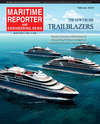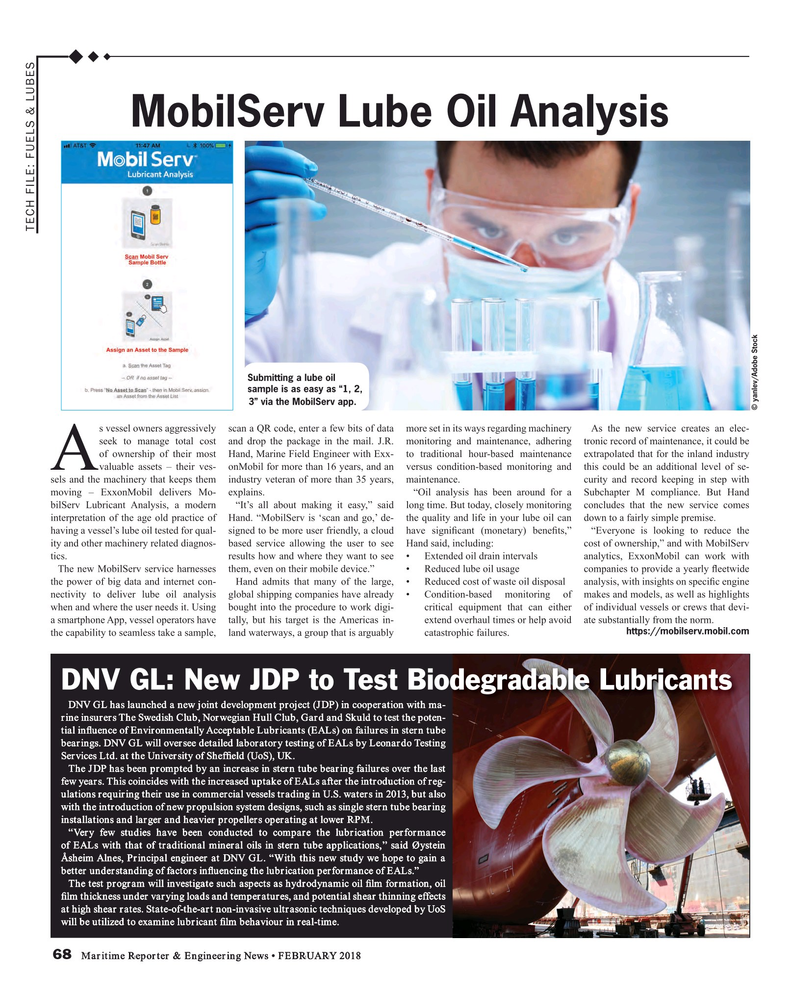
Page 68: of Maritime Reporter Magazine (February 2018)
Cruise Ship Annual
Read this page in Pdf, Flash or Html5 edition of February 2018 Maritime Reporter Magazine
MobilServ Lube Oil Analysis
TECH FILE: FUELS & LUBES
Submitting a lube oil sample is as easy as “1, 2, 3” via the MobilServ app.
© yanlev/Adobe Stock s vessel owners aggressively scan a QR code, enter a few bits of data more set in its ways regarding machinery As the new service creates an elec- seek to manage total cost and drop the package in the mail. J.R. monitoring and maintenance, adhering tronic record of maintenance, it could be of ownership of their most Hand, Marine Field Engineer with Exx- to traditional hour-based maintenance extrapolated that for the inland industry
Avaluable assets – their ves- onMobil for more than 16 years, and an versus condition-based monitoring and this could be an additional level of se- sels and the machinery that keeps them industry veteran of more than 35 years, maintenance. curity and record keeping in step with moving – ExxonMobil delivers Mo- explains. “Oil analysis has been around for a Subchapter M compliance. But Hand bilServ Lubricant Analysis, a modern “It’s all about making it easy,” said long time. But today, closely monitoring concludes that the new service comes interpretation of the age old practice of Hand. “MobilServ is ‘scan and go,’ de- the quality and life in your lube oil can down to a fairly simple premise.
having a vessel’s lube oil tested for qual- signed to be more user friendly, a cloud have signi? cant (monetary) bene? ts,” “Everyone is looking to reduce the ity and other machinery related diagnos- based service allowing the user to see Hand said, including: cost of ownership,” and with MobilServ tics. results how and where they want to see • Extended oil drain intervals analytics, ExxonMobil can work with
The new MobilServ service harnesses them, even on their mobile device.” • Reduced lube oil usage companies to provide a yearly ? eetwide the power of big data and internet con- Hand admits that many of the large, • Reduced cost of waste oil disposal analysis, with insights on speci? c engine nectivity to deliver lube oil analysis global shipping companies have already • Condition-based monitoring of makes and models, as well as highlights when and where the user needs it. Using bought into the procedure to work digi- critical equipment that can either of individual vessels or crews that devi- a smartphone App, vessel operators have tally, but his target is the Americas in- extend overhaul times or help avoid ate substantially from the norm.
https://mobilserv.mobil.com the capability to seamless take a sample, land waterways, a group that is arguably catastrophic failures.
DNV GL: New JDP to Test Biodegradable Lubricants
DNVGLhaslanchedanejointdeelopmentproject(JDP)incooperationithma DNV GL has launched a new joint development project (JDP) in cooperation with ma- rine insurers The Swedish Club, Norwegian Hull Club, Gard and Skuld to test the poten- tial in? uence of Environmentally Acceptable Lubricants (EALs) on failures in stern tube bearings. DNV GL will oversee detailed laboratory testing of EALs by Leonardo Testing
Services Ltd. at the University of Shef? eld (UoS), UK.
The JDP has been prompted by an increase in stern tube bearing failures over the last few years. This coincides with the increased uptake of EALs after the introduction of reg- ulations requiring their use in commercial vessels trading in U.S. waters in 2013, but also with the introduction of new propulsion system designs, such as single stern tube bearing installations and larger and heavier propellers operating at lower RPM.
“Very few studies have been conducted to compare the lubrication performance of EALs with that of traditional mineral oils in stern tube applications,’’ said Øystein
Åsheim Alnes, Principal engineer at DNV GL. “With this new study we hope to gain a better understanding of factors in? uencing the lubrication performance of EALs.”
The test program will investigate such aspects as hydrodynamic oil ? lm formation, oil ? lm thickness under varying loads and temperatures, and potential shear thinning effects at high shear rates. State-of-the-art non-invasive ultrasonic techniques developed by UoS will be utilized to examine lubricant ? lm behaviour in real-time.
68 Maritime Reporter & Engineering News • FEBRUARY 2018
MR #2 (66-73).indd 68 MR #2 (66-73).indd 68 2/8/2018 1:07:07 PM2/8/2018 1:07:07 PM

 67
67

 69
69
